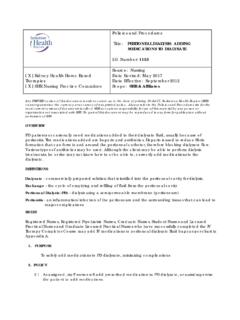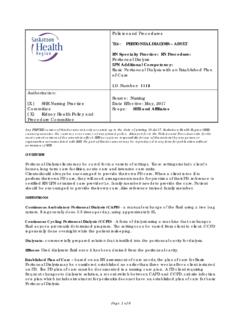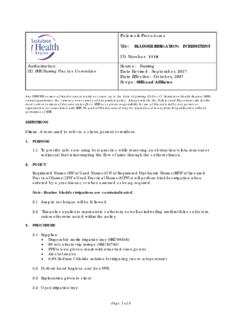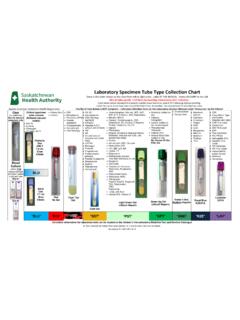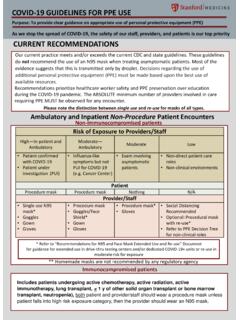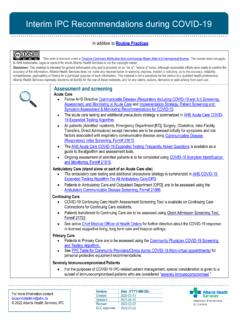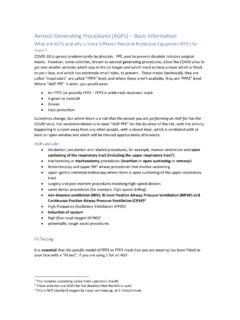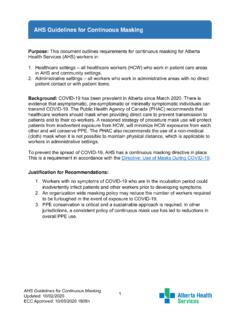Transcription of Policies and Procedures - Saskatoon Health Region
1 Page 1 of 16 Policies and Procedures Title: OXYGEN ADMINISTRATION ID Number: 1115 Authorization [X] Former SKtnHR Nursing Practice Committee Source: Nursing, Respiratory Therapy, Physiotherapy Date Revised: November 2020 Date of Previous Revision: March 2015 Date Effective: May 1999 Scope: SktnHR and Affiliates Any PRINTED version of this document is only accurate up to the date of printing 13-May-19. Saskatoon Health Region (SHR) cannot guarantee the currency or accuracy of any printed policy. Always refer to the Policies and Procedures site for the most current versions of documents in effect. SHR accepts no responsibility for use of this material by any person or organization not associated with SHR. No part of this document may be reproduced in any form for publication without permission of SHR.
2 DEFINITIONS: Arterial Blood Gas (ABG): a requisitioned lab test that analyzes arterial blood for oxygen (O2), carbon dioxide (CO2), bicarbonate (HCO3) content, and pH to reflect the effectiveness of lung function and gas exchange. Client: a term used to refer to a client, patient or resident. FiO2: the concentration of oxygen in the gas actually being inspired into the lungs and written as a fraction of 1 ( 40% oxygen = FiO2). Health Care Professional: for the purpose of this policy, Health Care Professional (HCP) will be used to refer to Registered Nurse (RN), Graduate Nurse (GN), Registered Psychiatric Nurse (RPN), Nurse Practitioner (RN(NP)), Licensed Practical Nurse (LPN), Graduate Licensed Practical Nurse (GLPN), Physician, Registered Respiratory Therapist (RRT), Anaesthesia Assistants, Paramedics, and nursing/respiratory/paramedic students.
3 Hypoxemia: a deficiency of oxygen in arterial blood, generally less than 80mmHg. Hypoxia: insufficient oxygen available to meet the metabolic needs of tissues and cells. Lpm: flow rate in litres per minute. Medical Air: consists of about 21% oxygen, 79% nitrogen (inert) and a small amount of other gases. Most Responsible Health Practitioner (MRHP): means the Health Practitioner who has the responsibility and accountability for the specific treatment/procedure(s) provided and prescribed to a patient and who is authorized by Saskatchewan Health Authority former Saskatoon Health Region (SKtnHR) to perform the duties required to fulfill the delivery of such a treatment/procedure(s) within the scope of their practice. SpO2: the measurement of functional saturation of oxyhemoglobin. This measurement is obtained non-invasively by pulse oximetry.
4 Policy & Procedure: Oxygen Administration #1115 Page 2 of 16 1. PURPOSE To safely administer oxygen to treat and prevent the symptoms of hypoxia. 2. POLICY Initiation of Oxygen A practitioner s order is required to initiate oxygen therapy, except in an emergency situation. A practitioner s order should include: O2 flow rate or FiO2, and, a titration of the oxygen flow rate in order to achieve an acceptable range of SpO2 values, 88-92%. In most cases, pulse oximetry is the preferred method of measuring blood oxygen values. In an emergency situation when a practitioner's order cannot be immediately obtained, oxygen may be temporarily initiated by a healthcare provider in the presence of any acute situation in which hypoxemia is suspected. A practitioner is to be contacted as soon as possible after initiation of oxygen therapy in emergency situations for verification and documentation of the necessity for oxygen therapy and to obtain any further orders.
5 In Home Care, the private home oxygen company contracted by the client will be responsible for the initiation, monitoring, management, and discontinuing of oxygen in their home. In Long Term Care the private home oxygen company contracted by the client will be responsible for the initiation, monitoring, management & discontinuing of oxygen in the home, in collaboration with the nursing team. Note: Nursing concerns based on assessment of a client s respiratory status, including oxygen saturation, will be directed to the home oxygen company, and if needed the client s practitioner, for follow up. Respiratory Therapy Services, if available, is to be consulted when any of the following devices are required: (see Appendix A) a large volume nebulizer with FiO2 greater than a non-rebreathing mask a high flow, high FiO2 nebulizer ( MistyOx ) a heated, humidified, high flow oxygen device ( Optiflow ) Oxygen therapy should be administered continuously unless the need has been shown to be associated with specific situations requiring intermittent use only ( exercise or sleep).
6 Policy & Procedure: Oxygen Administration #1115 Page 3 of 16 Oxygen delivered by nasal cannula at a rate of less than 4 Lpm will not be routinely humidified for adult clients. All oxygen administered by nasal cannula, to pediatric clients, should be humidified. (See Appendix A). Most portable oxygen cylinders have a full oxygen capacity of 2000 psi; if the pr essure gauge reads 500 psi or less, or if the pressure bar graph (if equipped) reads less than , the tank is considered empty and must be replaced. Monitoring of Oxygen Therapy Clients requiring a FiO2 of greater than 50% must have continuous pulse oximetry and be monitored in either an Emergency department, ICU or ward observation unit. (Exception palliative or end of life clients receiving oxygen for comfort measures). SpO2 will be measured on all clients, in acute care, requiring oxygen: Upon initiation When the oxygen flow rate or concentration is changed With a change in respiratory status With vital signs SpO2 will be measured on home care and long term care clients, as required, based on client assessment or if required for specific disease management ( respiratory disease).
7 Discontinuation of Oxygen A practitioner s order is required to discontinue oxygen therapy. Note: Criteria for discontinuation of oxygen may include: the client has stable vital signs the original disease process has resolved or greatly improved the client is able to maintain SpO2 values within or above their target range on room air for 24 hours. Infection Control All oxygen tubing (standard and large bore), humidifiers, large volume nebulizers (including MistyOx ), aerosol masks, and standard cannulas used to deliver oxygen are for single client use only. For all clients in acute care and long term care, change these items weekly and when visibly soiled. Document when equipment is due to be changed in care plan or label equipment with date to be changed. Heated, high flow oxygen system ( Optiflow ) wire circuit and humidifier chamber are not required to be changed regularly.
8 However, the interface of these systems should be replaced weekly. For home care clients, change items only when visibly soiled. Policy & Procedure: Oxygen Administration #1115 Page 4 of 16 aerosol generating oxygen delivery devices ( large volume nebulizers, high flow/high FiO2 nebulizers, and heated, humidified high flow devices using a mask or tracheostomy interface), should not be used on clients who are known or suspected to be infected Severe Acute Respiratory Syndrome (SARS), emerging respiratory syndromes that have not been clearly identified, or a microorganism transmitted by the airborne route ( tuberculosis, chicken pox, measles). If no alternative methods of oxygen delivery can be used other than aerosol generating oxygen delivery devices for those clients, they must be treated under Airborne Precautions in a negative pressure room.
9 Note: For clients on airborne and/or droplet precautions, aerosolized liquids and related equipment present a particular infection control hazard. Aerosols can pose a risk of transmission of infection to others. Standard bubble humidifiers or heated humidifiers ( Optiflow with nasal cannula interface), do not produce aerosols. When refilling humidifier bottles, any remaining water will be discarded and the bottle filled with distilled water (See Note below). Bottles will not be topped-up . Note: In acute care, sterile water must be used. In home care and long term care, distilled water may be used. Safe Handling of Oxygen/Equipment Oxygen vigorously supports combustion. Oxygen therapy equipment must not be used in the presence of open flame. No smoking is allowed in the vicinity of oxygen therapy equipment.
10 No heat source within metres of oxygen delivery system. Avoid use of items that create a spark ( Electric razors) with a nasal cannula in place. Oils and petroleum products are not to be used around the client s face. Oxygen cylinders are to be secured in a cylinder cart or bracket at all times. Do not use humidity on portable oxygen cylinders during patient transport. Oxygen must not be allowed to flow into the circuit of a BiPAP or CPAP unit that is not turned on. Ensure that the oxygen flow is turned off prior to turning off the BiPAP/CPAP unit. Note: The oxygen could flow back into the unit s electrical components causing a fire hazard when unit is turned back on. 3. PROCEDURE Assess clinical status of client, client history and check the practitioner s order for oxygen. Note: In clients with a history of COPD and CO2 retention, consult with the practitioner prior to initiating oxygen therapy to determine the need for ABGs or ABG results, except in emergency situations.
